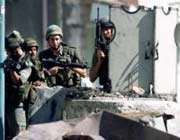What is the Intifada ?
It literally means "shaking off", and in this context it means to set free from the Israeli oppression.
The first intifada started on 8th Dec 1987 when four Palestinian men queuing at a checkpoint into Gaza were crushed to death by an Israeli army transporter. The second Intifada started on 28th Sept 2000 when Sharon with over 2,000 Israeli soldiers desecrated the Al Aqsa Mosque and killed 4 people.
The first Intifada 1987- 1993
The first Intifada (1987 - 1993), was a spontaneous explosion of popular resistance to the Israeli occupation, a resistance which had begun some fifty years before. The Palestinian people made a conscious and determined choice to consolidate their efforts in the struggle toward independence, regardless of the cost. The coordination of resistance activities through a body called The United Leadership of the Intifada, illustrated the depth and breadth of Palestinian aspirations for freedom. The force with which the Intifada began and continued for eight years stunned not only Israel, but indeed, all countries of the world.
One of the consequences of this first Intifada was the international conference in Madrid. No matter how frequently the negotiators met in Washington and elsewhere during this time, Israel refused to comply with the basic requirements for peace. United Nations resolutions 242 and 338 were suddenly not acceptable for Israel, not to mention Resolution 194, which calls for the right of refugees to return. The Madrid Conference served to divert the growing public awareness of Israel as an occupying power with a violent, oppressive, expansionist, colonialist, and racist character.
Two years later, the world was taken by surprise at the announcement of the Oslo Accord, signed in September 1993. While the world was sold a "peace myth," the reality was something quite different.
The primary aim of Oslo was to kill the Intifada and to ensure that Israel gained as many political benefits as possible, all the while transforming its identity into that of a peace-making country.
Israel did not withdraw from the occupied territories, as it had been agreed upon at Oslo. Hebron was divided. More land was confiscated. Jerusalemites were forced to relinquish their residency rights. Settlements increased at breakneck speed, which make the concept of Israeli withdrawal almost impossible (from an Israeli point of view, at least). Houses were demolished and trees were uprooted.
Finally, Palestinian lands were torn into areas A, B, and C (not to mention the complete closure of Jerusalem), creating easily- controllable and easily-suppressible bantustans.
During and after Oslo, the Palestinian people lived a nightmare of schizophrenia: pro-Oslo, contra-Oslo; Palestinians inside the territories, Palestinians outside; Gaza, West Bank; 1967 Palestinians, 1948 Palestinians; the Palestinian Authority marching to the tune of Oslo, the parliamentary opposition exercising its legitimate and democratic right within Palestinian society to reveal that Oslo was a dead end.
In the midst of all the confusion, most Palestinians were waiting patiently for Oslo to restore their national freedom, lost 33 years ago. They were waiting for Oslo to bring peace and prosperity. They were waiting to see how they could finally move freely within and outside the country. They were waiting for their prisoners to be freed. They were waiting for their own state where they could finally find peace and security. They were waiting for family reunions which would unite families who had not been together in 50 years.
The reality, however, quickly jarred their patient waiting. Instead of prosperity, the economic situation deteriorated to a level worse than in 1987.
Instead of experiencing unity, Palestinian lands were torn apart. In Hebron, for example, 400 Jewish settlers were given free reign to control and terrorize the lives of 120,000 Palestinian people (with the aid of the Israeli army).
The Palestinian people were subjected to a charade of evil and deceit. In addition, the Palestinian leadership, impotent in the face of Israeli aggression, agreed to seemingly unlimited concessions to Israeli demands - until there was no more to give. Instead of setting the stage for Palestinians to move toward freedom and independence, Oslo was dragging them toward fragmentation and surrender. Negotiations with the Israelis were starting to address the four points that had been postponed seven years earlier, namely: Jerusalem, the settlements, refugees, and the establishment of a state.

Not only is Israel unwilling to give back occupied East Jerusalem and to stop its settlement activity, it is unable even to recognize its moral and historic responsibility for the catastrophe of the Palestinians people. Israel rejects any responsibility for the Palestinian refugee problem. A Palestinian state may be "acceptable" to Israel, only if it is bereft of all the typical ingredients of a viable state, foremost among them, sovereignty.
Suddenly, we see the transformation of the establishment of a Palestinian state into an Israeli prerequisite for the completion of its hegemony.
Any peace agreement that might be signed based on these conditions would amount to an agreement of surrender on the part of the Palestinians. The Paris Economic Protocol (1996), on which Israel insists any future relations be based, is one example of the intended circumcision of the coming Palestinian State.
Other links:
Special Edition on Gaza “Genocide of Humanity”
Zionism - the Greatest Danger
Gaza In Pictures Photo Gallery